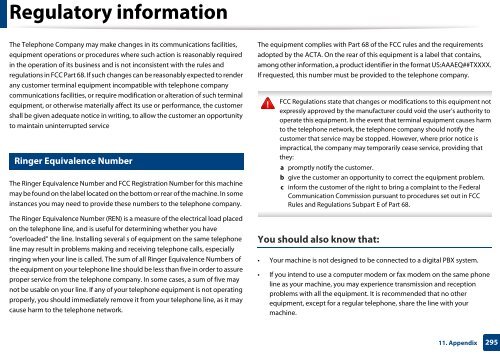Samsung Multifunzione b/n MultiXpress SL-K7500GX (A3) (50 ppm) - User Manual_36.16 MB, pdf, ENGLISH
Samsung Multifunzione b/n MultiXpress SL-K7500GX (A3) (50 ppm) - User Manual_36.16 MB, pdf, ENGLISH
Samsung Multifunzione b/n MultiXpress SL-K7500GX (A3) (50 ppm) - User Manual_36.16 MB, pdf, ENGLISH
You also want an ePaper? Increase the reach of your titles
YUMPU automatically turns print PDFs into web optimized ePapers that Google loves.
Regulatory information<br />
The Telephone Company may make changes in its communications facilities,<br />
equipment operations or procedures where such action is reasonably required<br />
in the operation of its business and is not inconsistent with the rules and<br />
regulations in FCC Part 68. If such changes can be reasonably expected to render<br />
any customer terminal equipment incompatible with telephone company<br />
communications facilities, or require modification or alteration of such terminal<br />
equipment, or otherwise materially affect its use or performance, the customer<br />
shall be given adequate notice in writing, to allow the customer an opportunity<br />
to maintain uninterrupted service<br />
25<br />
Ringer Equivalence Number<br />
The Ringer Equivalence Number and FCC Registration Number for this machine<br />
may be found on the label located on the bottom or rear of the machine. In some<br />
instances you may need to provide these numbers to the telephone company.<br />
The Ringer Equivalence Number (REN) is a measure of the electrical load placed<br />
on the telephone line, and is useful for determining whether you have<br />
“overloaded” the line. Installing several s of equipment on the same telephone<br />
line may result in problems making and receiving telephone calls, especially<br />
ringing when your line is called. The sum of all Ringer Equivalence Numbers of<br />
the equipment on your telephone line should be less than five in order to assure<br />
proper service from the telephone company. In some cases, a sum of five may<br />
not be usable on your line. If any of your telephone equipment is not operating<br />
properly, you should immediately remove it from your telephone line, as it may<br />
cause harm to the telephone network.<br />
The equipment complies with Part 68 of the FCC rules and the requirements<br />
adopted by the ACTA. On the rear of this equipment is a label that contains,<br />
among other information, a product identifier in the format US:AAAEQ##TXXXX.<br />
If requested, this number must be provided to the telephone company.<br />
FCC Regulations state that changes or modifications to this equipment not<br />
expressly approved by the manufacturer could void the user’s authority to<br />
operate this equipment. In the event that terminal equipment causes harm<br />
to the telephone network, the telephone company should notify the<br />
customer that service may be stopped. However, where prior notice is<br />
impractical, the company may temporarily cease service, providing that<br />
they:<br />
a promptly notify the customer.<br />
b give the customer an opportunity to correct the equipment problem.<br />
c inform the customer of the right to bring a complaint to the Federal<br />
Communication Commission pursuant to procedures set out in FCC<br />
Rules and Regulations Subpart E of Part 68.<br />
You should also know that:<br />
• Your machine is not designed to be connected to a digital PBX system.<br />
• If you intend to use a computer modem or fax modem on the same phone<br />
line as your machine, you may experience transmission and reception<br />
problems with all the equipment. It is recommended that no other<br />
equipment, except for a regular telephone, share the line with your<br />
machine.<br />
11. Appendix<br />
295
















